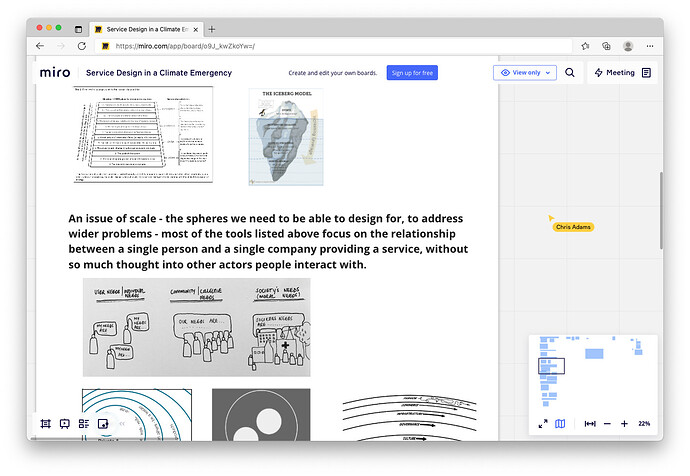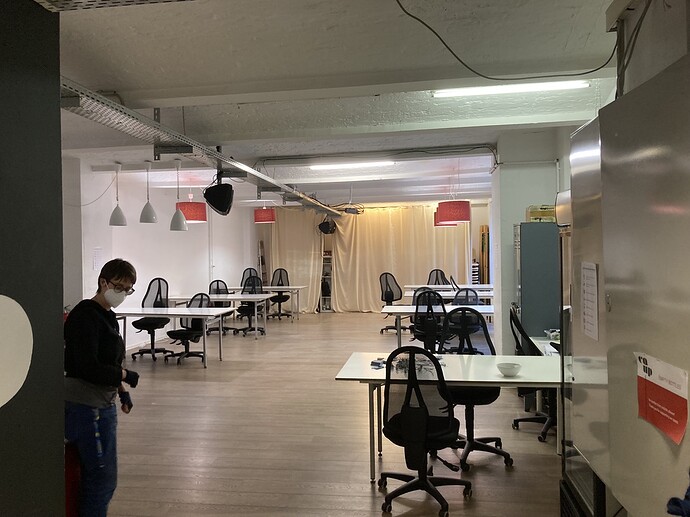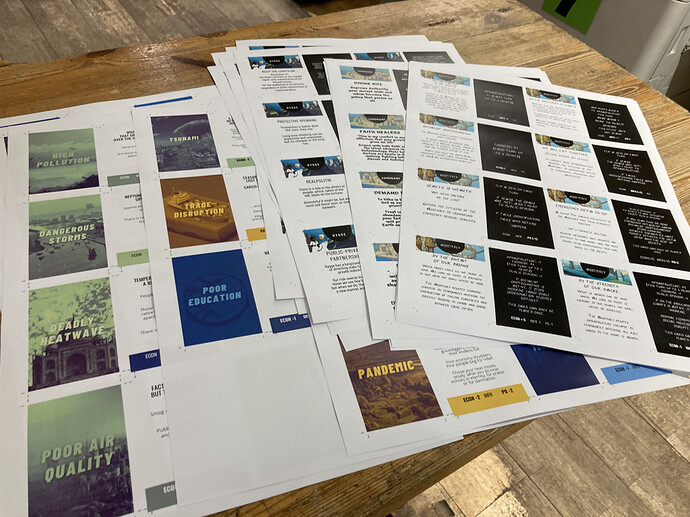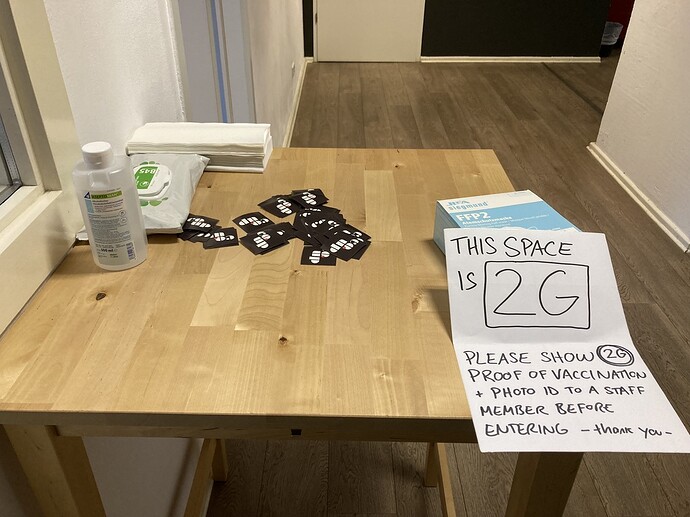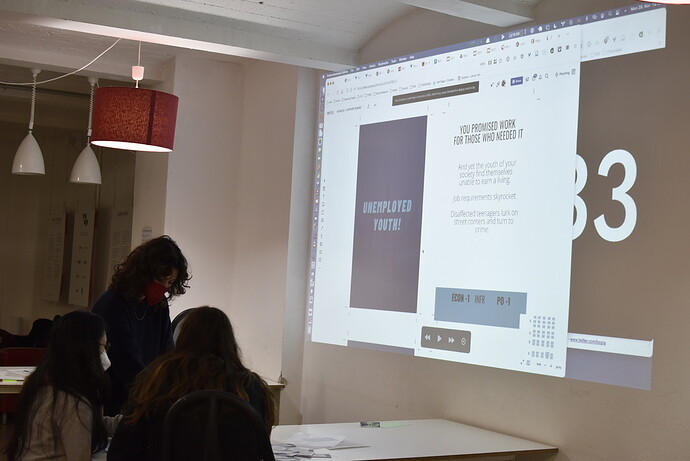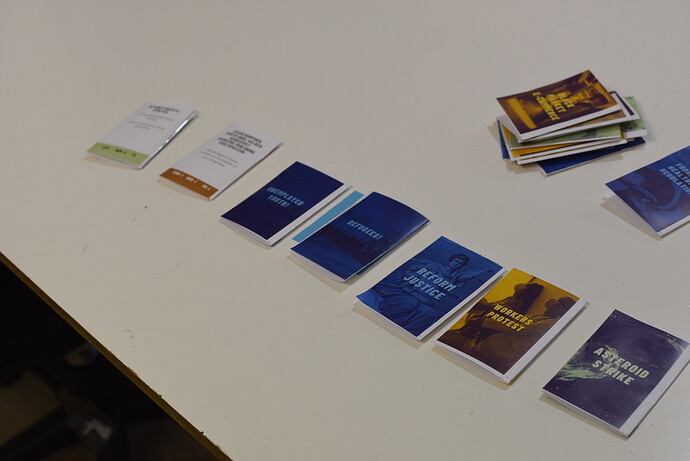yup. We underestimated the level of interest both in terms of how many people might show up, as well as how much time those who did would be willing to put in.
Some question for the hosts of the other rooms (@ivan and @alberto,@nadia I got some notes for Hygge) :
- how many people introduced themselves in the chat (%)?
- how many people talked in the first, second and third round respectively?
- how many people voted in the different rounds?
- how was the general mood in the conversation? (playful, optimistic/engaged, whateveristic, frustrated)
In Hygge @nadia tell me if you had the same feeling
- I’ll say 60% of the participants did that (we had a spectrum of introduction from in the world to realistic to funny ones)
- 3/4 every session, some like 7/8 people spoke in total (30%), plus some random comment that was picked up and facilitated into the conversation (Hey I saw this comment, what do you mean by that @name? )
- 7/8
- playful, engaged (with one comment that expressed frustration), but I will not say that it was a RPG style of conversation (with element of worldbuilding in it or people being characters).
Overall it seemed to me a good play-test for the game, the small RPG elements worked well, if I have to highlight the best moment I will say that the audio-tracks (the train ![]() ) were very powerful, everybody with their camera on was closing their eyes and enjoy the vision. I know that is not inherent with the game mechanics, but
) were very powerful, everybody with their camera on was closing their eyes and enjoy the vision. I know that is not inherent with the game mechanics, but ![]() maybe it’s worth focusing on these things?
maybe it’s worth focusing on these things?
Funny that you mention the quiet year @alberto I’ve used it a lot in class (a tweaked version of 60 minutes), using it to explore topics like slavery, capitalism and colonization (we are in the US after all ![]() and it was able to create great in and off game conversations, I think it’s such a wonderful and accessible RPG.
and it was able to create great in and off game conversations, I think it’s such a wonderful and accessible RPG.
That’s called the Good Problem, right?
I mean, a whole lot of the narrative content (that I grokked anyway) was interrogative as to broader concepts/tropes, the philosophical gestalt triggered mostly by the card name?
Which was curtailed by time pressure, but felt a bit rorschach potentially?
My first impression is broadly aligned with yours. I wonder that it might have been different with a different facilitator- I found it quite challenging tbh. Especially since the game was originally intended to be played offline in smaller group with physical cards, with the online interaction being limited to the post game discussions.
We cancelled the physical event in Brussels, but @mrchrisadams ran an offline version with people playing physical cards together over a longer time. It would be interesting to hear how that experience panned out. Both in terms of gaming dynamics, use of points and rpg elements…but also in terms of the quality/depth/topics in the conversations/discussions.
Out of curiosity, I looked some numbers using the transcription software:
Assembly
Voice: 15 speakers in total. Speaker 8 (20%), Speaker 1 (18%), Speaker 2 (14%), Speaker 5 (12%), Speaker 10 (6%), Speaker 3 (5%), Speaker 12 (4%), Speaker 4 (4%), Speaker 6 (3%), Speaker 7 (3%), Speaker 13 (2%), Speaker 14 (2%), Speaker 15 (1%), Speaker 9 (1%), Speaker 11 (1%)
Covenant
Voice: 14 speakers. Speaker 1 (38%), Speaker 8 (23%), Speaker 2 (13%), Speaker 9 (4%), Speaker 14 (4%), Speaker 13 (4%), Speaker 3 (3%), Speaker 10 (2%), Speaker 4 (2%), Speaker 11 (1%), Speaker 7 (1%), Speaker 12 (1%), Speaker 5 (1%), Speaker 6 (<1%), Speaker 15 (<1%)
Hygge
(Unclear because this recording included hygge breakout room, follow up summaries by ambassadors and discussions in the post event networking …)
Voice: 21 speakers in total. Speaker 1 (48%), Speaker 2 (8%), Speaker 7 (3%), Speaker 5 (3%), Speaker 6 (3%), Speaker 15 (3%), Speaker 8 (2%), Speaker 3 (2%), Speaker 10 (2%), Speaker 19 (2%), Speaker 18 (2%),Speaker 13 (2%), Speaker 14 (2%), Speaker 4 (2%), Speaker 11 (2%), Speaker 12 (1%), Speaker 9 (1%),Speaker 20 (1%), Speaker 16 (1%), Speaker 21 (1%), Speaker 17 (<1%)
huh? Not sure I follow the rorschach bit?
Apologies. Given the uh bounded rationality of not knowing policy effects or domains in detail, the cards were a bit like a rorschach inkblot?
Ah, interesting. Read up on Rorschach. Do you mean it is an unreliable diagnotic test for the health of different political/economic systems? or something else?
Hi everyone, I took part in the Witness event on Monday and I’ve been thinking about the experience a lot since then – I’m fascinated by the Witness world-building! So I thought I’d share some additional feedback; please note that I’m totally new to this space and probably missing a lot of relevant background, but I hope you can still find some of this useful ![]()
A note on my background: I worked at various tech startups and have done a fair amount of digital UX design. I’m not a game designer but I took an introduction to game design course a couple of years ago and designing a board game was part of the course. I do enjoy playing different types of games though.
Overall user experience
- Having what appeared to be an interactive web app was a bit confusing; I saw several people asking why nothing happens when they click on the cards in the chat.
- Suggestion: use the static cards page until a functional interactive version is ready. Maybe use something like Trello for quick prototyping and playtesting.
- Deciding which cards to play was awkward using chat.
- Suggestion: use the Zoom polling feature or a third-party shared space that makes it easy for people to vote, something like a shared Miro whiteboard (a shared whiteboard could also be used to lay out the available cards.)
- Group size: as already mentioned, the groups were probably a bit too large. As most of us were strangers, the large size and limited time made it difficult to establish trust and make more people comfortable with speaking up.
- Suggestion: playtest in smaller groups, have more time available for discussion, and maybe try out different game mechanics with the same group.
- @nadia: I thought you did a good job facilitating the session, I particularly liked how you invited people to speak up on the voice channel (which is often awkward to do in large groups of strangers). The intro part where you describe your background in Hygge was perhaps a bit too long (or maybe I was just eager to try the game
 ), and it might be helpful to get more directions on what’s expected from us, the new council members fresh off the train
), and it might be helpful to get more directions on what’s expected from us, the new council members fresh off the train 
- Suggestion: set clearer expectations and roles at the beginning of the play session (see notes below).
Gameplay and immersion
-
The rules of the game weren’t clear and I feel that lack of clarity took people out of the experience. (Questions that popped up: How many cards can we play? How many rounds will there be, do we need to save the one-time actions for bigger catastrophes later? How do we win, how do we die?)
-
Suggestion: Write a game rulebook, distribute it beforehand and go through it during the event introduction. Some resources on the topic:
-
-
Story immersion: I took the time to read the materials and website a few hours before the event and that spiked my curiosity but this approach might not work for everyone. I found the intro voice-over videos set the world quite well. From the perspective of the story, I wasn’t quite sure why would new arrivals – who are obviously clueless about how things are run in the Distrikt – be asked to participate in the council? I love the idea of earning your stay with a year of public service but having people who lack context and expertise on the council makes me wonder about the quality of decisions.
- Suggestions: Maybe prepare some sort of welcome package for new council members to help with immersion. It could include a dashboard with key Distrikt indicators (economic, well-being…), news headlines to set the scene and tone of the Distrikt better, etc. Or have players play more clearly defined characters (see next comment).
-
During introductions, it wasn’t clear whether we should introduce ourselves in the present time or create a character (which is difficult to do in a time-limited setting).
- Suggestion: Maybe have characters with background stories that players can choose in advance to better anchor their experience?
-
Choice paralysis: I got the feeling that several in our Distrikt didn’t want to vote on cards until they were 100% clear on the rules and consequences.
- Suggestions: On the one hand, this makes me think they took the game very seriously and were afraid of the consequences
 but on the other hand, the point of games is to experiment and to learn new strategies from failure, so maybe think of ways the experience could be presented as more playful and experimental? And to make it clear that we can all learn from failure. I suppose the success of such games depends a lot on the group of people playing it; how much experience they have with games (incl. dying in games and trying again) and how comfortable they are with role playing, especially in a group of strangers. Again, setting clearer expectations beforehand might help.
but on the other hand, the point of games is to experiment and to learn new strategies from failure, so maybe think of ways the experience could be presented as more playful and experimental? And to make it clear that we can all learn from failure. I suppose the success of such games depends a lot on the group of people playing it; how much experience they have with games (incl. dying in games and trying again) and how comfortable they are with role playing, especially in a group of strangers. Again, setting clearer expectations beforehand might help.
- Suggestions: On the one hand, this makes me think they took the game very seriously and were afraid of the consequences
-
The structure was pretty linear and I kept wondering how big of an effect our decisions actually have; as was discussed in the final part of the event, can we die, or is this a pretty much no-risk game, which makes it more boring?

- Suggestions: It might be interesting to introduce an element of randomness with a dice toss borrowed from role playing games to show that even the “best” choice can end up backfiring because complex systems are unpredictable. Basically, experiment a bit more with what works in other popular games.
-
General suggestion: Finding the fun, the tricky part of game design! More playtesting and experimenting with different game mechanics will be needed to find the elements that make the game fun. I got the impression that we ended up being the most engaged at the end of the event when comparing scores between Distrikts
 but I’m not sure that’s the goal of the game?
but I’m not sure that’s the goal of the game?
Some additional game design resources that might come in handy:
I suppose I mean participant policy choice as an emotional affinity or dislike of the connotations of the card titles?
So less ‘this might solve the problem’, more ‘is this a narrative I’m into’
Putting it another way, there’s two sort of trends within role-playing games generally - there are the people who like a mathsy/tactical vibe, and people who are into dressing up and pretending. They are both super-fun!
(it’s also the source of the old joke, that rpgs exist so nerds can potentially mate, hahaha)
So what I’m maybe getting at here is to do with what one wants a game to elicit more of - open-ended narrative exploration, versus simulation-type testing. The former seems more anthropologically interesting, the latter closer to wargaming scenarios.
The other bit I’d flag is the short iterations (turns=3) doesn’t give time for factionalisms to emerge - curious on the group dynamics once ‘blocs’ or tendencies within the groups emerge - I’m presuming they would?
Super helpful, thank you!
Yes Minister should be at the core of any introduction course Public Administration 
But indeed there’s a piont well made here. In real life elderly men, ministers etc. make their decisions based upon advice of civil servants AND lobby-groups. So one could incorporate these dynamics into the game.
Cool! The breakout rooms were 50 minutes so if a Speaker is 1% it means that they contributed 30 seconds (0.5 minutes)?
yes I think so
Ok so it looks to me like we might do a fork with two different games that have different mechanics. One that is more of a strategy/mathsy/tactical as @thom_stewart puts it below. And another which is very people who like to dressing up and pretending.
The original version (printed cards) falls under the former. Here’s the gameplay guide: A5-PrintReady_Booklet_Gameplay.pdf (10.2 MB)
Need to figure out a nice way to make the cards accessible and editable/ modifiable. While ensuring they still look nice.
The “let’s dress up and pretend” version is something we started looking into before the event. I’ve posted a wiki with what is there so far: Learning from the event: A no-points RPG version?
Both versions are still in their infancy and we can develop them together then share them freely if anyone is interested.
Thank you so much, a thoughtful post-mortem. Very generous of you. ![]()
I guess on the ‘finding the fun’ part, I’ve often found there’s a rich seam of Play in the ‘what are you bad at?’ aspects - like specific handicaps.
This comes up a lot in minmaxing rpg character builds, or if we are taking a faction model, sid meiers alpha centauri is a nice example, or the original board game of Dune for something really asymmetric.
So rather than a crisis being ‘vanilla’ to all factions, their specific ‘flavour’ could have quite significant effects on policy choice constraints?
To go further, I know meta governance issues were flagged in our group - the ‘how do we make decisions?’ thing. It didn’t get explored too far, but I could easily imagine hyggean/assembly/etc having different norms for decisionmaking.
Another errant thought would be that given that Witnessites have fairly frictionless rights of Exit, comparatives between Distrikts turn by turn could easier be a source of fun?
Hi folks.
I helped run a play testing session of the Witness game this week in Berlin on Nov 29th, as a companion to the virtual event run by the EdgeRyders. Here’s my writeup.
How I got involved
Back in 2019, Kathryn Hing and I ran Service Design in an Climate Emergency, a workshop as part the Edgeryders’s festival, to explore some of the systemic issues around incorporating an awareness of climate into disciplines like Service Design.
One of the reasons for this is that Service Design techniques are increasingly used as part of transformation projects for both private and public sector services, and this perspective is probably best summarised by a quote from Matt Edgar, service director at NHSX and NHS England:
Most of government is mostly service design most of the time.
This quote expanded in a fairly well known blog post in digital public sector circles, and worth a read.
Anyway, you can see some resources elsewhere on this site, along with a cool visual summary of the day:
Also, one of the take-aways from the day was that people in their current practice didn’t really have the language to effectively talk about the challenges climate change presents in a way that would let them prioritise one form of climate action over another, or even be able to talk about trade-offs on climate versus other priorities they might have. Unsurprisingly, it was pretty hard to have a useful discussion within the confines of how they were employed to work as services designers, and ones frequently in private sector organisations.
We ended up dropping a number of images onto Miro board before and after the event, making it available to attendees (you can have a look for yourself if you fancy).
While the event was interesting, we didn’t really try to follow up with future sessions, until earlier this year.
Fast forward to 2021, and getting nerd sniped
Earlier this year, I got totally nerd sniped by @nadia with this topic in the internet of humans forum here, and after I found a willing co-conspirator, ended up working on organising an event in Witness.
I mean, if the confines of working as a service designer in late stage capitalism made if hard to talk about effective action, perhaps exploring these under different economic systems might help?
Prepping for the event
Where we ran it:
We ended up using co-up, a well known community space in the open source community in Berlin. I’ve been running going to and running events there since 2015, and we got it for free (it was the first event they had running in their venue since the pandemic began). It normally has space for ~70 people, but during the pandemic, the maximum capacity with the windows and the rest, was less than 20. You can see it below, in co-working configuration.
Getting word out
I help organise climateAction.tech - an online community of about 5000 technologists, and the weeks up to the event, we initially piggy backed off the original eventbrite and edgeryders promo to include links to the event in the weekly CAT (climateAction.tech) newsletter.
We did some direct promo as well, but we largely leaned on the newsletter for reaching people, and the social media channels we had available to us.
A couple of weeks before the event, we realised that piggy backing off the original edgeryder event made it hard to see if we had signups, or communicate with attendees. We ended up creating a separate eventbrite
On the Friday 26th before the event on 29th Nov, we had 17 signups.
Arranging props for play testing
Unfortunately for a card game, the UPS shipment that was sent from Belgium in good time for us to use during the day ended up not making it to us.
So, instead, on Monday, I ended up printing and cutting out card decks for a significant chunk of the day to use for the evening, at a nearby print shop. On the upside, this did at least afford a chance to read the cards, and understand the various effects in more detail:
Printing out the cards and cutting them into two packs of cards with guillotines, and then sticking them together took most of the morning, and a chunk of the afternoon. I think if I was to do this again, I might think about seeing if there was a way I could upload the PDFs to Moo.com, or similar, to have them as print-on-demand options closer to the event.
Play testing on the day virtually
Both Katrin and I had a chance to join the virtual event at lunch time on Monday - this was really useful before the event, and I don’t think we would have felt anywhere near as comfortable running the event in the evening without attending it, and I’d go so far as to require something like this for prospective hosts in future.
In the middle of a pandemic, seeing the game open with the pandemic card made us really, hope we wouldn’t lead with it, as it seemed to negate a bunch of work done already to establish a sense of distance from where we are now, economcally and politically.
Also, running through the audio intro as a player was helpful - once we had an idea of what it was like to be a player, it was much easier to facilitate with that in mind in the evening.
Running the event
While the sign below shows this as a 2G event, we ended up running it as a 2G+ (everyone needed negative tests, plus recovery or vaccine)
Of the 17 sign ups, 8 turned up in total, including us, so (60% drop out rate)
These included:
- Business students from the Mondragon cooperative in the Basque Country - they were visiting Berlin for new ideas, and well. this was an event of new ideas…
- Analysts working on the German Federal Hydrogen Strategy
- Folks at TU Berlin, designing their own game for exploring the circular economy (within sustainability circles, I’ve learned that there’s a bit of pushback against the circular economy concept, because it’s seen as a way to avoid questioning the idea of economic growth as a societal goal)
- Designers and developers looking for new climate themed projects or jobs
Our layout
To begin with, we had considered totall changing the layout for the space, but with 17 signups, and the whole pandemic set up, we ended up following the plan below:
1 - Opened with the audio intro, after a little bit of introduction using the slide deck at - bit.ly/witness-bln-2021
2- Have 6 tables set aside - 2 tables per distrikt (so people in the same distrikts afterwards can compare their responses to events after the game)
- 2x hygge
- 2x assembly
- 2 covenant
Each table had the cards and the A4 1 pager explaining them. The idea here was that attendees could read about the different distrikts, then decide where to ‘migrate to’.
On each table, we had a couple of A4 sheets listing the possible policy response cards, and we asked players not to turn over cards until they had actually played any card.
Some ended up laying out the cards like so - so they could see which cards were in play, and which were still available
This wasn’t universal, but seemed interesting enough to share, as I hadn’t thought of the portfolio of responses for a distrikt being laid out like this:
What our distrikts faced
Because we had a number of groups, but not so many event cards, we laid out the cards in a miro board, and used a projector to show everyone what the event cards meant:
This helped us explain the cards to the multiple groups. After explaining the cards, we set a timer of 5 minutes for each group to discuss their distrikt’s response, before choosing a card, and tracking how many points were left.
This was a bit of an executive decision on our part - to be honest, we were a bit worried about getting stuck with an event like pandemic like the lunchtime playtest. In that case, we were both Hygge, and spending the game time, talking about how something like Europe might would handle a pandemic didn’t seem very far from our day to day.
We had small groups, and being able to explore how the different distrikts respond differently over time to different events seemed more in keeping with the idea of the event. The players seemed to respond positively to the tension introduced by the timer, and meant that we had quite a high chance of seeing events unfold.
We also figured in a real policy context, you’re making decisions with incomplete information, often in a hurry, so it was easy enough to work into the game.
All in all, we lasted 7 rounds, which ran to a little over an hour.
These were the events we dealt with.
- High pollution
- Brain Drain
- Youth Unemployment - this killed off Hygge. We had no idea distrikts could die so quickly!
- Refugees - because we had such small groups, rather than having a group sit out the game, and we worked the migrant train into the in-game narrative. We split the former hyggians into the two remaining distrikts, as refugees from the fallen distrikt.
- Reform Justice - the players were pleasantly surprised to see positive cards appear - felt more hopeful
- Worker protest - this killed off the Covenant last players
- Asteroid Strike - because the groups were all enjoying the story, we checked to see what came next for the surviving distrikt, the Assembly. This event would have killed them off too.
Key learning points from playing the game
-
The feedback was broadly positive, and even though Katrin and I weren’t too experienced, it was still a fun game - the world seemed rich, and the non-Hyiggian players spoke about how much they enjoyed reading the different policy ideas for card.
-
Almost all the players struggled to understand the NGI/ internet technology link suggested in the event material - it seemed entirely about economics and politics.
-
People wanted to share their post game experiences, and see what the others were doing - we didn’t have a good way to recap this, and even after the game discussing what the groups did was hard.
-
Players wanted to see how other groups were responding to the same event, and it felt like this wasn’t supported well. With no interaction between the distrikts, or real incentive to see how they are doing, it can feel like 3 separate games, and if you’re one distrikt, part of the appeal seems to be comparing how you handle a crisis with how another one does. Having a mechanism to capture between turns which of the distrikt’s seems best prepared to face future events might prompt this kind of interaction, without messing with the game mechanics - perhaps a quick poll, or timebox for discussion.
-
In its card game guise, it’s really hard to see policy interventions stack up over time if you don’t have easy access to the relevant pages on netlify, as there is no visual cue on the printed cards. We couldn’t keep track of this from turn to turn properly.
Further written feedback from Katrin, based on transcribing some of the notes
- Points: it was not 100% clear to us how the points-system worked; especially with special cards that had an effect on every further turn of the game we were not sure if we played and calculated them correctly
- Can one card be played twice? Because you already know how many points you’ll get if you play it again…
- Is it a maximum of 5 points or can you collect more than 5?
- Some statistics / hard facts about each city/ideology would have been appreciated to get into the game and mindset more easily
- The Digital tech angle was not so present; participants expected a stronger focus on it though
- Unexpected things were happening: this was a great learning for how politics and policy making work and was also a lot of fun
- We migrated one group to another city after they lost at 0 points; this was a really well received, and kept the game going for everyone
- Wording of cards: the wording of all cards (and also of the game in general) should be much more accessible; many concepts that people don’t understand are on it with no explanation; and an old/high-level vocabulary is used that is very hard to understand for Non-English native speakers.
More info
See the photos in the witness google drive folder, along with captured written feedback from players
https://drive.google.com/drive/folders/1tg-1hZOs7-va0vYrNXNrjYZc3l5xNQea?usp=sharing
See the google doc with some of Nadia’s question prompts earlier this week:
Hope that helps! I’m happy to answer questions, and I’ll try to answer them promptly, but I can’t promise I’ll get to them all quickly.
Chris this is so so helpful - thank you! Btw do you still have the, I am guessing, modified files that you used to physically print the cards? Might be nice to be able to share them with others in the future…

